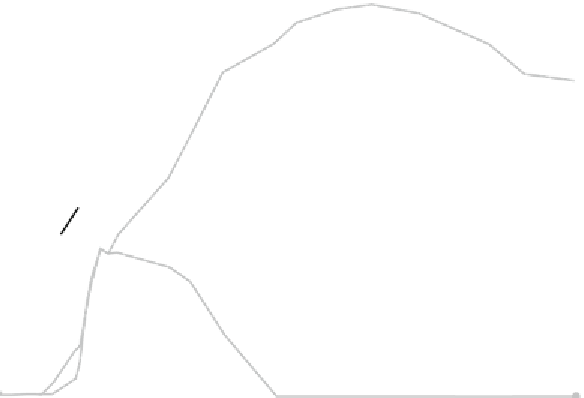Biomedical Engineering Reference
In-Depth Information
9.6.2 Growth and Competition
P. stutzeri
KC can be grown aerobically or under denitrifying conditions with several
electron donors, including complex organics, such as nutrient agar, acetate, glycerol and
vegetable oils (soybean and canola). Remediation efforts to date have focused on the use of
acetate. A growth curve typical of acetate-fed denitrifying cells is shown in Figure
9.7
. Like
other denitrifying
P. stutzeri
, strain KC stoichiometrically converts nitrate to nitrite followed by
sequential reduction of nitrite to NO, N
2
O, and nitrogen gas.
As already noted, an important consideration in aquifer bioaugmentation with strain KC is
the niche that the added cells will occupy after introduction. In order for PDTC-mediated CT
degradation to occur, the added strain KC cells must compete successfully with the native
microflora. A difficulty is that the native microbial community are adapted to the extant
biogeochemical conditions. This advantage can be overcome by altering conditions to favor
growth of added strain KC. Because strain KC is an efficient iron-scavenger and capable of rapid
growth under iron-limited conditions, it can be given a competitive advantage by adjusting the pH
to near 8 prior to inoculation (Dybas et al.,
1995b
). Figure
9.8
illustrates the maximum specific
growth rates for strain KC and indigenous microflora in the Schoolcraft, Michigan aquifer.
From Figure
9.8
, it is clear that
P stutzeri
KC has a competitive advantage at pH values
above 7.8 in competition with denitrifying microflora from the Schoolcraft, Michigan, aquifer.
This may in part be due to the production of PDTC itself since PDTC behaves as an antagonist
for competing populations (Sebat et al.,
2001
).
Table
9.2
gives additional insight into the nature of the competitive advantage afforded
strain KC by pH adjustment at the Schoolcraft site, comparing maximum specific growth rate
35
0.30
30
0.25
Optical density
25
0.20
20
0.15
Acetate
Nitrate
15
0.10
10
Nitrite
0.05
5
0
0.00
0
2
4
6
8
10
12
14
16
18
Time (days)
Figure 9.7. Growth curve for denitrifying P. stutzeri KC: acetate is the electron donor; nitrate is the
electron acceptor; initial pH ¼ 8 (Knoll,
1994
).







































































































Search WWH ::

Custom Search